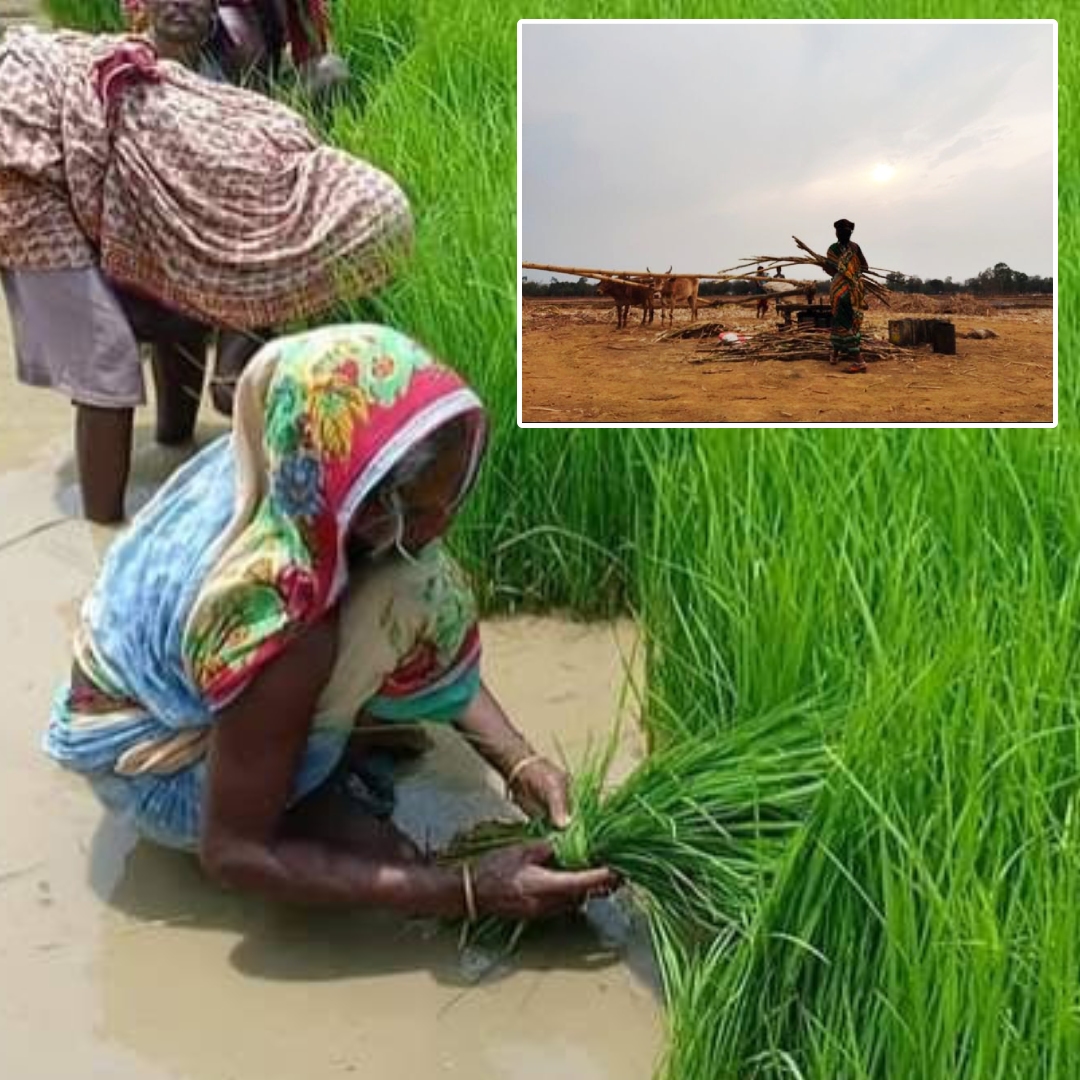In the easternmost state of India, Odisha, climate change has led to a significant increase in floods leading to large-scale devastation of crops and livelihoods. Those primarily dependent on natural resources and agriculture for their livelihood are the worst sufferers as they lose their source of income and food.
Climate Change impacts food security in multiple ways by affecting cultivation, forestry, aquaculture, etc., which can cause severe socio-economic consequences like the disruption of trade, livelihood distress, and adverse health effects.
Located in the southern part of Odisha, the Koraput district’s population is significantly dependent on agriculture. In fact, the traditional farming methods practised by the Indigenous communities of Koraput has been recognised by the Food and Agriculture Organization (FAO) as a Globally Important Agricultural Heritage System (GIAHS).
In the Kotpad Block of the Koraput district, two prominent villages, the Asana and Bonia, are primarily dominated by the tribal communities – the Omanatyas and the Bhottadas, respectively, mainly engaged in agricultural activities. Endowed with rich agro-ecological conditions such as good water availability like- closeness to river Indravati and adequate irrigation facilities, clayey soil makes the region conducive for agricultural activities. The Observed Rainfall Variability and Changes Over Odisha State data released by the Indian meteorological department states the significant increasing rainfall trend in Koraput during southwest monsoon season. Therefore, the inherent socio-economic and political arrangements coupled with crop devastation due to increased floods and precipitation influence the villagers’ food security in varied ways.
In the Kotpad Block of the Koraput district, two prominent villages, the Asana and Bonia, are primarily dominated by the tribal communities – the Omanatyas and the Bhottadas, respectively, mainly engaged in agricultural activities. Endowed with rich agro-ecological conditions such as good water availability like- closeness to river Indravati and adequate irrigation facilities, clayey soil makes the region conducive for agricultural activities. The Observed Rainfall Variability and Changes Over Odisha State data released by the Indian meteorological department states the significant increasing rainfall trend in Koraput during southwest monsoon season. Therefore, the inherent socio-economic and political arrangements coupled with crop devastation due to increased floods and precipitation influence the villagers’ food security in varied ways.
Lachman Pujari, a farmer, residing in Asana village, said, “In the recent years, we have started facing many issues during the floods as the cultivation area gets filled with water destroying our crops which is a huge loss for us. Moreover, the entrance of our village near the school gets flooded, making it difficult for us to go out for work.”
Climate Change And The Drivers Of Food Security
Food security is conceptualised as people having physical, social, and economic access to nutritious foods to maintain a healthy life. Based on this, food security initially focused on three specific dimensions- availability, access, and absorption. However, as per the new High Level Panel of Experts on Food Security and Nutrition (HLPE) report 2020, food security focuses on six dimensions- availability, access, utilisation, stability, agency, sustainability.
Food availability is primarily associated with food production in which various factors come into play, such as irrigation systems, access to land, water, forests, etc. Climate change has also adversely affected these variables, especially the increase in floods have significantly affected food availability.
According to the Indian government data shared in Lok Sabha, 2021, due to floods, the country has suffered a considerable crop loss on 18.176 million hectares of land, roughly 8.5 per cent of the total gross cropped area from 2017-2019.
In both the villages, Asana and Bonia, the agricultural production is satisfactory considering the favourable agro-ecological conditions ensuring food availability to the villagers. However, it is only during the monsoons that heavy flooding leads to crop destruction and disrupts food availability, ultimately compromising food consumption patterns.
Food access encapsulates adequate access to resources (entitlements) for procuring appropriate foods for a nutritious diet. Amartya Sen (1981) defines entitlements as the set of all commodity bundles over which a person can establish command given the legal, political, economic and social arrangements of the community they live in (including traditional rights such as access to shared resources). Climate-related stress can negatively affect these factors, resulting in the amplification of food insecurity.
Effect Of Floods In The Region
The disruption in agricultural productivity during the floods affects the food and income source of the villagers as a large proportion of them are mainly agrarian labourers. Although only a few of them engage in diverse works during the monsoons to earn, the majority is still involved in the cultivation. Lack of options for work diversification deprives them of buying food products from the markets, compromising certain nutritious food items. In fact, travelling to the markets become difficult for the villagers as they are either highly flooded or muddy, which even prevents the shopkeepers from selling food products.
Moreover, the lack of healthcare facilities in the villages leads to increased spending as they have to travel long distances to avail such facilities. Therefore, increased spending on healthcare often compromises the food security scenario in the poorer households of the villages and vice-versa, which significantly intensifies during floods.
“As the village gets flooded, it becomes tough to go out of our houses to visit a hospital during emergencies. Moreover, during those days, the electricity gets disrupted, which makes it difficult to contact anyone in need as our mobile phones remain dead considering the fact that we cannot even manage to charge it,” said Subhash Majhi, a resident of Bonia village.
Immense Pressure On Women
Women of the villages mainly engage in carrying out agricultural activities such as weeding, sowing which are considered easier jobs by the villagers compared to the tough jobs such as ploughing done by men. The wage rate received by the women in carrying out these tasks is also very low, reducing their ability to purchase adequate and diverse foods. Since the responsibility of feeding is mainly associated with women, it leads to immense pressure for women and increases the time spent searching for food during the floods. Gobinda Majhi, a resident of Bonia village, mentioned how cooking becomes difficult during floods as the water penetrates the houses and the devastation of some houses also occurs.
Therefore, various kinds of dry foods like stored dried fish tubers that are easily digestible are preferred. Additionally, in terms of prevailing religious discrimination, there is a chance of an increase in contestation among those already poor and the prevailing disasters adding more to it.
Adaptation And Policy Support
Kanakdei Majhi of the Bonia village said, ” Earlier, vegetable cultivation was done near the Indravati river, but increased flooding has led to its destruction. Therefore, the villagers have started cultivating sugarcane in these areas as it can easily resist heavy flooding. And, after it gets over, we use the patu mati (fertilised mud) for vegetable cultivation.”
Besides being vulnerable to climate-induced disasters like floods, the villagers adopt various adaptation techniques for survival and food security to a certain extent. During the field investigation, it was noticed that the villagers carry out sugarcane plantations in the sandy soil areas closer to the rivers. These plants contain water tolerance properties, and they can easily resist the water overflow stress caused during flooding. It also helps them earn certain economic gains from selling, and the sugarcane waste is also used as fuel, which is a viable, sustainable option.
Some of the villagers also prefer to migrate to the nearby Kotpad town in search of alternative sources of income. However, as there are limited opportunities available, the villagers prefer to rely on agriculture due to the favourable agro-ecological conditions that support agriculture. And, storing of specific food items for unforeseen situations is also practised by the villagers.
“When the government announces the possibility of high floods, we immediately escape to a safe place in Kotpad. But, as floods have become very usual for us during the monsoons, we try our best to store our rice, kerosene, paddy on the elevated surfaces in our houses as water cannot reach there,” said Abhimanyu Pujari of Asana village.
Government Support
The government needs to give more focus to encouraging these adaptive strategies. Crops should be promoted and provide policy support considering the local agro-ecological conditions and the associated climate-related stress.
The Odisha Millet Mission, which operates in certain parts of Odisha, is a welcome move as it encourages household consumption of millets and ensures minimum support price (MSP) for farmers. Because it requires less water for cultivation, it is regarded as a climate-smart crop that provides nutritional security.
The Public Distribution System (PDS) also comes to the rescue by providing items such as rice for the villagers. A recent initiative by the Odisha government to include nutritious millets is applaudable.
More focus needs to be devised to understand the differential impact of climate change at the local level intertwined with food security issues, especially regarding availability and access, which will help provide holistic pictures and deliver effective policies. The Pradhan Mantri Krishi Bima Yojana tends to overlook this as it emphasises giving support based on the number of crops being destructed at the panchayat level. The Asana villagers couldn’t avail any assistance from the Yojana as 60% of crop loss all over the Panchayat is the demarcation.
Furthermore, the need for more discussions on floods concerning peripheral areas like Asana or Bonia needs to arise as a majority of it tends to revolve around the coastal districts of Odisha, which experience heavy flooding.
This article is derived from the field observations of the TIGR2ESS (Transforming India’s Green Revolution by Research and Empowerment of Sustainable food supplies) Project, FP-6a, carried out by the field workers at the Kalinga Institute of Social Science, Bhubaneswar, India. The TIGR2ESS Project is a collaborative research project with the University of Cambridge. This team is led by Dr Nitya Rao, Professor of Gender & Development, School of International Development at the University of East Anglia, UK.)












